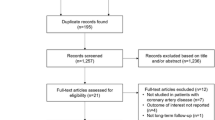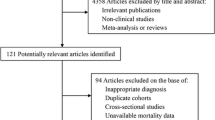Abstract
Pulmonary hypertension (PH) can occur in patients with obstructive sleep apnea (OSA) in the absence of cardiac or lung disease. Data on the development and severity of PH, and the effect of continuous positive airway pressure (CPAP) therapy on pulmonary artery (PA) pressures in these patients have been inconsistent in the literature. We sought to determine whether CPAP therapy affects PA pressures in patients with isolated OSA in this meta-analysis. We searched PubMed, Medline, EMBASE and other databases from January 1980 to August 2015. Studies of patients with OSA, defined as an apnea–hypopnea index >10 events/h, and PH, defined as PA pressure >25 mmHg were included. Two reviewers independently extracted data and assessed risk of bias. A total of 222 patients from seven studies (341.53 person-years) had reported PA pressures before and after treatment with CPAP therapy. 77 % of participants were men, with a mean age of 52.5 years, a mean apnea–hypopnea index of 58 events/h, and mean PA pressure of 39.3 ± 6.3 mmHg. CPAP treatment duration ranged from 3 to 70 months. Using fixed effects meta-analysis, CPAP therapy was associated with a decrease in PA pressure of 13.3 mmHg (95 % CI 12.7–14.0) in our study population. This meta-analysis found that CPAP therapy is associated with a significantly lower PA pressure in patients with isolated OSA and PH.




Similar content being viewed by others
References
Colish J, Walker JR, Elmayergi N, Almutairi S, Alharbi F, Lytwyn M, Francis A, Bohonis S, Zeglinski M, Kirkpatrick I, Sharma S, Jassal DS (2012) Obstructive sleep apnea: effects of continuous positive airway pressure on cardiac remodeling as assessed by cardiac biomarkers, echocardiography, and cardiac MRI. Chest 141:674–681
Basner RC (2014) Cardiovascular morbidity and obstructive sleep apnea. N Engl J Med 370:2339–2341
McLaughlin VV, Archer SL, Badesch DB, Writing Committee Members, ACCF Task Force Members (2009) ACCF/AHA 2009 expert consensus document on pulmonary hypertension: a report of the American College of Cardiology Foundation Task Force on Expert Consensus Documents and the American Heart Association: developed in collaboration with the American College of Chest Physicians, American Thoracic Society, Inc., and the Pulmonary Hypertension Association. Circulation 2009(119):2250–2294
Minai OA, Ricaurte B, Kaw R, Hammel J, Mansour M, McCarthy K, Golish JA, Stoller JK (2009) Frequency and impact of pulmonary hypertension in patients with obstructive sleep apnea syndrome. Am J Cardiol 104:1300–1306
Golbin JM, Somers VK, Caples SM (2008) Obstructive sleep apnea, cardiovascular disease, and pulmonary hypertension. Proc Am Thorac Soc 5:200–206
Alchanatis M, Tourkohoriti G, Kakouros S, Kosmas E, Podaras S, Jordanoglou JB (2001) Daytime pulmonary hypertension in patients with obstructive sleep apnea: the effect of continuous positive airway pressure on pulmonary hemodynamics. Respiration 68:566–572
Dark DS (1996) Sleep apnea and pulmonary hypertension. Chest 109:300–301
Chaouat A, Weitzenblum E, Krieger J, Oswald M, Kessler R (1996) Pulmonary hemodynamics in the obstructive sleep apnea syndrome. Results in 220 consecutive patients. Chest 109:380–386
Sajkov D, Wang T, Saunders NA, Bune AJ, Neill AM, Mcevoy RD (1999) Daytime pulmonary hemodynamics in patients with obstructive sleep apnea without lung disease. Am J Respir Crit Care Med 159:1518–1526
Tilkian AG, Guilleminault C, Schroeder JS, Lehrman KL, Simmons FB, Dement WC (1976) Hemodynamics in sleep-induced apnea. Studies during wakefulness and sleep. Ann Intern Med 85:714–719
Podszus T, Bauer W, Mayer J, Penzel T, Peter JH, von Wichert P (1986) Sleep apnea and pulmonary hypertension. Klin Wochenschr 64:131–134
Guyatt GH, Oxman AD, Vist G, Kunz R et al (2011) GRADE guidelines: 4. Rating the quality of evidence—study limitations (risk of bias). J Clin Epidemiol 64:407–415
Laks L, Lehrhaft B, Grunstein RR, Sullivan CE (1995) Pulmonary hypertension in obstructive sleep apnoea. Eur Respir J 8:537–541
Laks L, Lehrhaft B, Grunstein RR, Sullivan CE (1997) Pulmonary artery pressure response to hypoxia in sleep apnea. Am J Respir Crit Care Med 155:193–198
Chaouat A, Weitzenblum E, Kessler R, Oswald M, Sforza E, Liegeon MN (1997) Five-year effects of nasal continuous positive airway pressure in obstructive sleep apnoea syndrome. Eur Respir J 10:2578–2582
Niijima M, Kimura H, Edo H, Shinozaki T, Kang J, Masuyama S, Tatsumi K, Kuriyama T (1999) Manifestation of pulmonary hypertension during REM sleep in obstructive sleep apnea syndrome. Am J Respir Crit Care Med 159:1766–1772
Bady E, Achkar A, Pascal S, Orvoen-Frija E, Laaban JP (2000) Pulmonary arterial hypertension in patients with sleep apnoea syndrome. Thorax 55:934–939
Sajkov D, Wang T, Saunders NA, Bune AJ, McEvoy RD (2002) Continuous positive airway pressure treatment improves pulmonary hemodynamics in patients with obstructive sleep apnea. Am J Respir Crit Care Med 165:152–158
Arias MA, Garcia-Rio F, Alonso-Fernandez A, Martinez I, Villamor J (2006) Pulmonary hypertension in obstructive sleep apnoea: effects of continuous positive airway pressure: a randomized, controlled cross-over study. Eur Heart J 27:1106–1113
Krieger J, Sforza E, Apprill M, Lampert E, Weitzenblum E, Ratomaharo J (1989) Pulmonary hypertension, hypoxemia, and hypercapnia in obstructive sleep apnea patients. Chest 96:729–737
Sajkov D, Cowie RJ, Thornton AT, Espinoza HA, McEvoy RD (1994) Pulmonary hypertension and hypoxemia in obstructive sleep apnea syndrome. Am J Respir Crit Care Med 149:416–422
Sun X, Luo J, Xiao Y (2014) Continuous positive airway pressure is associated with a decrease in pulmonary artery pressure in patients with obstructive sleep apnoea: a meta-analysis. Respirology 19:670–674
Atwood CW Jr, McCrory D, Garcia JG, Abman SH, Ahearn GS (2004) American College of Chest P. Pulmonary artery hypertension and sleep-disordered breathing: ACCP evidence-based clinical practice guidelines. Chest 126:72S–77S
Fletcher EC, Schaaf JW, Miller J, Fletcher JG (1987) Long-term cardiopulmonary sequelae in patients with sleep apnea and chronic lung disease. Am Rev Respir Dis 135:525–533
Sforza E, Laks L, Grunstein RR, Krieger J, Sullivan CE (1998) Time course of pulmonary artery pressure during sleep in sleep apnoea syndrome: role of recurrent apnoeas. Eur Respir J 11:440–446
Faller DV (1999) Endothelial cell responses to hypoxic stress. Clin Exp Pharmacol Physiol 26:74–84
Ahmed T, Oliver W Jr, Wanner A (1983) Variability of hypoxic pulmonary vasoconstriction in sheep. Role of prostaglandins. Am Rev Respir Dis 127:59–62
Foster GE, Poulin MJ, Hanly PJ (2007) Intermittent hypoxia and vascular function: implications for obstructive sleep apnoea. Exp Physiol 92:51–65
Kourembanas S, McQuillan LP, Leung GK, Faller DV (1993) Nitric oxide regulates the expression of vasoconstrictors and growth factors by vascular endothelium under both normoxia and hypoxia. J Clin Invest 92:99–104
Hannan RL, Kourembanas S, Flanders KC, Rogelj SJ, Roberts AB, Faller DV, Klagsbrun M (1988) Endothelial cells synthesize basic fibroblast growth factor and transforming growth factor beta. Growth Factors 1:7–17
Perkett EA, Badesch DB, Roessler MK, Stenmark KR, Meyrick B (1992) Insulin-like growth factor I and pulmonary hypertension induced by continuous air embolization in sheep. Am J Respir Cell Mol Biol 6:82–87
Shweiki D, Neeman M, Itin A, Keshet E (1995) Induction of vascular endothelial growth factor expression by hypoxia and by glucose deficiency in multicell spheroids: implications for tumor angiogenesis. Proc Natl Acad Sci USA 92:768–772
Kholdani C, Fares WH, Mohsenin V (2015) Pulmonary hypertension in obstructive sleep apnea: is it clinically significant? A critical analysis of the association and pathophysiology. Pulm Circ 5(2):220–227
Ignarro LJ, Byrns RE, Buga GM, Wood KS (1987) Endothelium-derived relaxing factor from pulmonary artery and vein possesses pharmacologic and chemical properties identical to those of nitric oxide radical. Circ Res 61:866–879
Garg UC, Hassid A (1989) Nitric oxide-generating vasodilators and 8-bromo-cyclic guanosine monophosphate inhibit mitogenesis and proliferation of cultured rat vascular smooth muscle cells. J Clin Invest 83:1774–1777
Nakaki T, Nakayama M, Kato R (1990) Inhibition by nitric oxide and nitric oxide-producing vasodilators of DNA synthesis in vascular smooth muscle cells. Eur J Pharmacol 189:347–353
Phelan MW, Faller DV (1996) Hypoxia decreases constitutive nitric oxide synthase transcript and protein in cultured endothelial cells. J Cell Physiol 167:469
Kolar F, Ostadal B (1991) Right ventricular function in rats with hypoxic pulmonary hypertension. Pflugers Arch 419:121–126
Berkowitz R, Alhaj E, Manchikalapudi RB, Satya K, Dadfarmay S, Zakir R (2010) Determinants of right ventricular failure in patients admitted with acute left heart failure. Congest Heart Fail 16:243–248
Duchna HW, Myslinski W, Dichmann M, Rasche K, Schultze-Werninghaus G, Orth M (2006) Cardiac structure and function in patients with obstructive sleep apnea syndrome and co-prevalent arterial hypertension. Influence of CPAP therapy. Med Klin (Munich) 101(1):1–8
Abou Shehata ME, El-Desoky ME, Maaty AE, Abd-ElMaksoud AM, Suliman LA (2013) Pulmonary hypertension in obstructive sleep apnea hypopnea syndrome. Egypt J Chest Dis Tubercu 62:459–465
Marvisi M, Vento MG, Balzarini L, Mancini C, Marvisi C (2015) Continuous positive airways pressure and uvulopalatopharyngoplasty improves pulmonary hypertension in patients with obstructive sleep apnoea. Lung 193:269–274
Funding
No funding was received for this study.
Author information
Authors and Affiliations
Corresponding author
Ethics declarations
Conflict of interest
Dr. Ashtyani has served as an expert witness regarding pulmonary hypertension. All other authors declare no conflict of interest.
Rights and permissions
About this article
Cite this article
Imran, T.F., Ghazipura, M., Liu, S. et al. Effect of continuous positive airway pressure treatment on pulmonary artery pressure in patients with isolated obstructive sleep apnea: a meta-analysis. Heart Fail Rev 21, 591–598 (2016). https://doi.org/10.1007/s10741-016-9548-5
Published:
Issue Date:
DOI: https://doi.org/10.1007/s10741-016-9548-5




